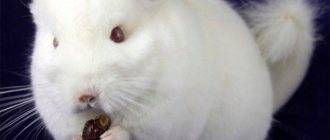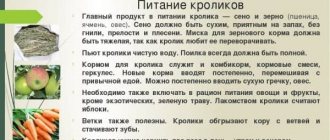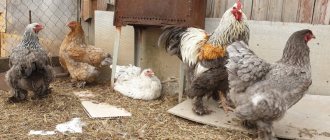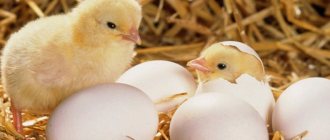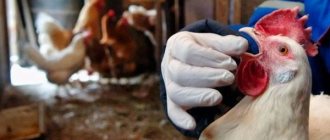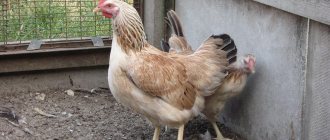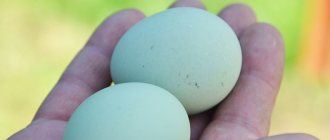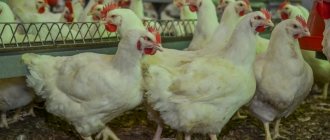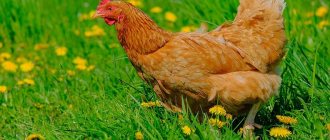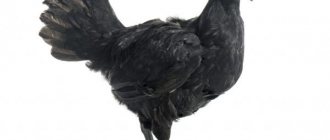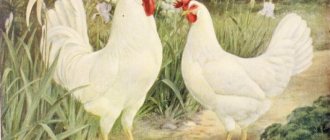Home » Articles about chickens » Paduan chicken breed
The Paduan breed belongs to the decorative category - one cannot expect great productivity from chickens. Despite the fact that decorative birds do not bring serious benefits, they are of great interest to true connoisseurs.
Description
A characteristic feature of this breed of chickens is the presence of feathers on the head. Paduans have a thick beard and a lush, symmetrical crest. The bottom of the neck is densely feathered, which gives it massiveness. The plumage of the birds is dense, uniform, the down is thick and soft.
Roosters are taller and larger than chickens, but their bodies are narrower. The chickens are squat, with a denser build. The chest is raised, which makes the posture proud. The comb and earrings are almost invisible - they are small outgrowths.
The presence of a pronounced scallop leads to culling.
The eyes are brown, with a reddish-yellow tint allowed. The beak is yellow or blue-gray, curved down, strong. The wings are short. The tail of males is curved in the shape of a sickle. The metatarsus is light purple or bluish.
Females have a calm character, males can be cocky, but do not cause serious problems. Birds are susceptible to colds and arthritis, but otherwise they have good immunity.
Origin story
There is no reliable information about the place of origin of the Paduan chicken breed. According to some reports, she comes from the Italian city of Padua. In other sources there is information that these chickens originate in England. It is known that the first representatives of the breed line were bred by the German Frisch in 1763.
The first paduans had golden-red plumage, but later, thanks to continuous breeding work, other colors were obtained - blue, silver, shaman. After crossing the Paduan with Pavlovian chickens, changes occurred in its appearance - a crest and beard appeared on its head.
Attention! Bearded and beardless chickens of this line were divided into 2 separate breeds. Birds with a beard and crest began to be called Paduans, the rest were called Dutch.
Russians became acquainted with the breed at the end of the 18th century. At that time they were used as a source of dietary meat and eggs. Today these chickens are bred as ornamental chickens.
Colors
The description of the breed states that Paduan chickens have several subspecies that differ in their color:
- white - on the white plumage there may be inclusions of black in the form of stripes or spots, the crest is very fluffy, the legs are long, the metatarsals are bluish-violet;
- black – the crest is lush, the plumage color is black, the tint is green, cream or white inclusions are possible on the main background;
- golden - the plumage has a bright orange color with a golden tint and black edging, the main background contains splashes of lilac or white, the crest is lush, the neck is heavily feathered;
- Chamois - birds are similar to the golden variety, but there is a white edge on the yellow-orange feathers;
- silver - white plumage, with black edging and a glossy silver tint, black crest;
- blue - the plumage has a lead or bluish color, it smoothly transitions from light to dark;
- calico - the main color is brown, black and white inclusions are evenly distributed throughout the body, the tail and crest are almost uniformly black in color.
In addition to the standard size, dwarf individuals weighing up to 1 kg have also been bred. The peculiarity of the dwarf subspecies is its loose, lush plumage.
Photo gallery
Photo 1. Two types of Paduan colors
Photo 2. A brown Paduan walks in the grass Photo 3. Close-up of a Paduan's muzzle
Photo 4. Paduan resting on a branch Photo 5. Black Paduan at home
Photo 6. Silver-black Paduan
Productivity
In accordance with the description, Paduan chickens belong to the decorative category; they do not have pronounced productivity in terms of meat or eggs. According to farmers, the weight of chickens rarely exceeds 2 kg (the average is 1.5 kg). Roosters are slightly superior to them - up to 2.1-2.5 kg.
Egg production in females is low - up to 100-120 pcs. in year. This is more than that of fighting breeds, but less than that of meat and egg breeds. The shell color is white or beige, depending on the color. Weight 1 pc. – up to 45-55 g (30 g for dwarf individuals).
Birds can be kept for decorative purposes and to produce offspring. Life expectancy is 10-12 years, but by the age of 7 the appearance loses its showiness, the feathers thin out, and the crest becomes less symmetrical.
Diseases
Representatives of the Paduan breed have good immunity to viral diseases, but often catch colds or suffer from diseases of the digestive tract. This can be completely avoided by raising birds in a warm, clean environment and carefully selecting the optimal diet.
- Parasites
- Infectious
- Other
Chicken mite
How to treat a chicken coop and how to treat a bird. Description of drugs and methods of control
Read
Coccidiosis
Thirst, loss of appetite, swelling, bloody droppings, anemia, weakness, poor coordination
Read
Ascariasis
Loss of appetite, liquid droppings, pale mucous membranes of the comb, limbs, ruffled plumage, lethargy, vomiting
Read
Amidostomiasis
Symptoms of the acute form: apathy, general weakness, decreased or lack of appetite, breathing problems, unsteady gait, retarded growth and development
Read
Prostagonymosis
Decreased mobility, loss of appetite, unsteady gait, bloating, fever, impaired egg laying, exhaustion
Read
Knemidocoptic mange (“lime foot”)
Acute symptoms: light gray bumps appear on the legs, the bird limps and stands on one leg, the cloaca and joints become inflamed, the beak is deformed
Read
Heteracidosis
Symptoms: indigestion, diarrhea, loss of appetite, lethargy, decreased egg production, retarded growth and development
Read
Trichomoniasis
Symptoms of the acute form: fever, depression and loss of appetite, diarrhea with gas bubbles and a putrid odor, enlarged goiter, difficulty breathing and swallowing
Read
Pullorosis (typhoid fever, salmonellosis)
Weakness, lack of coordination, drooping eyelids, difficulty breathing, lack of appetite, indigestion
Read
Colibacillosis
Lack of appetite, thirst, sudden increase in temperature, pale scallops, diarrhea
Read
Pasteurellosis
Fever, foamy mucus, change in stool color, refusal to feed, thirst, lethargy, wheezing, heavy breathing
Read
Marek's disease
Paralysis of the limbs, difficulty breathing, severe exhaustion and loss of strength, refusal of food and water, pallor of the scallop
Read
Gumboro disease
Diarrhea, loss of appetite, trembling legs and head, sudden death
Read
Laryngotracheitis
Weakness, swelling of the neck, difficulty breathing, cough, wheezing, blood clots in the mucus released when coughing, lack of appetite, indigestion
Read
Bird flu
Refusal to eat, anorexia, diarrhea, purulent discharge, hoarse breathing, greenish-brown droppings, seizures, darkening of the ridge
Read
Newcastle disease
Decreased appetite, fever, respiratory distress, immobility, conjunctivitis, bloody diarrhea
Read
Apteriosis
Complete or partial absence of plumage, loss of tail feathers, broken embryonic fuzz in young animals, delayed growth of plumage, pecking
Read
Pterophagy
Plucking and eating feathers. What is the reason, why does it require urgent intervention and how to prevent the disease?
Read
Yolk peritonitis
Symptoms of the acute form: loss of appetite, gray-green color of feces, sudden drop in egg production, calcareous deposits on the shell, bluish tint and baldness of the abdominal skin
Read
Cloacite
Symptoms: depressed state, decreased appetite, weight loss, increased need for water, loss of plumage, inflammation and bulging of the cloaca, the presence of ulcers on the mucous membrane, decreased egg production
Read
Growing paduans
Despite the dense feather cover, Paduans are susceptible to colds - they are kept in warm chicken coops. The walking area is equipped with a roof - during precipitation, the birds get very wet and can get sick because of this.
Due to their tendency to arthritis, Paduans are kept on a warm floor - double wooden flooring is made, and a thick layer of bedding material is used. During the cold season, birds are released for walking in dry and relatively warm weather. In winter, the site is insulated with a layer of straw, sawdust, and hay.
Contaminated bedding from nests and from the floor must be removed frequently, replacing with fresh and dry bedding.
Drafts are excluded - the poultry house will have to be equipped with supply and exhaust ventilation. This will allow exhaust air to be removed from the room, fresh air to be supplied, and the optimal level of humidity to be maintained.
Thick plumage needs special attention - troughs with a sand-ash mixture for dry bathing are installed indoors and on the run (purified sulfur can be added to enhance the effect).
Content
In order for bird care to bear fruit, you must follow the basic rules of keeping:
- The poultry house should be warm, dry, comfortable and spacious. The perches must be built as single-tiered ones, where each individual will have at least forty centimeters of timber.
- To maintain health and beauty, you need a high-quality, balanced diet.
- In order to maintain a pleasant appearance, it is important to take care of the dryness and cleanliness of the chicken coop. It is recommended to carry out cleaning at least once every two days.
Feeding
Immediately after hatching, chicks must be fed crushed chicken eggs. Then, after two or three days, chopped fresh cottage cheese, dry corn grits and finely chopped soft greens can be introduced into the diet. Specialized feed mixtures are recommended to be given from the second week. In addition, it is important to ensure that clean water is always present in the drinking bowls. Containers for it should be chosen heavy and high enough so that the chickens do not have the opportunity to tip it over. Read about the maintenance and care of the Amrox chicken breed at this link.
Mixtures of feed mixtures and mixed feeds must be given once a day - during the day. It is also useful to include animal protein (cottage cheese, curdled milk), fresh herbs and hay, seasonal vegetables and fruits (melons, root vegetables, potatoes, cabbage) in the menu. In addition, it is important to monitor the presence of chalk, meat, bone and fish meal, as well as vitamin complexes in the diet. If there is a shortage of substances, they can be added directly to the mash.
It is recommended to feed adult birds with grain mixtures (wheat, barley, oats). Such products are given to chickens twice a day - morning and evening.
To prevent possible infections, it is useful to periodically give a weak solution of potassium permanganate instead of clean water.
Care
In order to provide the chickens with proper care, it is necessary to prepare for them a warm and dry ready-made barn, or a home-made chicken coop, as well as a walking area. It is recommended to equip the poultry house with an additional artificial heating system, since Paduans are afraid of the cold. It is important to cover the floor with a bedding of hay or straw, which will need to be removed and replaced with each cleaning. To increase the length of daylight hours indoors, it is necessary to install an incandescent lamp.
Sanitation must be carried out once a week. To do this, you can use slaked lime, a solution of caustic soda or potassium permanganate. It is advisable to do the same with feeders and drinkers. Potassium permanganate is usually used to process them. Find out about breeding Rhodonite chickens in this article.
Chickens are prone to colds, so insulating the barn must be taken very seriously. The temperature in the chicken coop should vary from 23 to 26 degrees.
The walking area should be built with walls no lower than one and a half meters. It is recommended to surround it with a net or picket fence. In the warm season, such a pen should have drinking bowls constantly filled with clean water, as well as feeders. In addition, from the site itself, individuals should have constant free access to the chicken coop itself and under the canopy.
In order to prevent diseases of chickens, it is necessary to protect them from contact with wild birds and animals, as well as from dampness.
Feeding
Pedigree chickens need high-quality nutrition - they are given feed appropriate for their age. If it is unprofitable to purchase a finished product, you can prepare feed mixtures yourself. These include:
- crushed grains of corn, wheat and other crops (fraction - up to 2 mm);
- corn dirt (source of fiber);
- vegetable oil (up to 10 g/1 head per day) – fats are necessary to maintain feather quality;
- mineral supplements, including sources of calcium (this category includes bone meal, shell, chalk);
- vitamin complexes.
Birds also need:
- root vegetables - along with grains, they become a source of carbohydrates;
- Boiled legumes (beans, beans, peas) - contain amino acids necessary for birds;
- green food - in summer the birds eat it fresh, in winter the Paduans are given grass meal, pine needles, alfalfa and clover hay.
The birds are provided with fresh water. It is not recommended to use ordinary drinkers due to the bushy beard - nipple models are more suitable.
Advantages and disadvantages
The beautiful plumage and proud appearance of these interesting birds is already an undoubted advantage. But, besides this, they have a meat direction. Paduans also have a good disposition and a calm character. They are peaceful, easily get used to their owner, and can be handled. They don't like to start fights or make a lot of noise.
In general, these are almost ideal ornamental chickens. Birds are capable of incubating eggs, but often refuse to do so. Therefore, it is advisable to purchase an incubator to increase the chances of the number of chicks produced. Young animals require careful care, as their survival rates are very low.
Paduans attract everyone's attention, but they are kept quite rarely, even on private territories. The reason for this is several significant disadvantages. The first is difficulties in breeding. In addition, the conditions for keeping the breed in cold countries are quite difficult. You need heating for the chicken coop and a lot of vitamins so as not to spoil the beauty of the bird in winter frosts. Moreover, chickens are quite expensive: one young bird costs from 550 rubles.
Breeding
In addition to the small number of eggs, there is another drawback - female Paduans very rarely become brood hens. To produce offspring, the eggs they lay will have to be placed under other hens or an incubator must be used. It is advisable to keep hatched chicks separately from other breeds. Conditions in the first week should be “greenhouse” - not lower than +30 degrees. Feeding during this period is once every 2 hours. The food is mashed boiled egg and PK-0 compound feed.
Incubation
Incubators are mainly used to hatch chickens; the conditions for them are standard. The optimal temperature in the incubator is 39 degrees, the period is 3 weeks, plus or minus 1 day.
Table of temperature and humidity modes
| Period |
